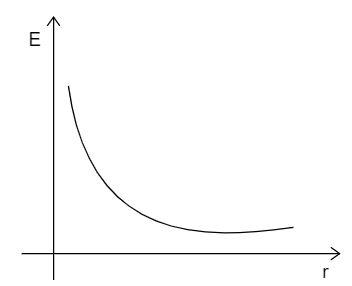
Answer
414.3k+ views
Hint: Use the formula of the gauss law to calculate the electric field over a particular area. If the perpendicular distance between the line of charges increases, then its electric field decreases, based on this fact drawn from the graph. Use the work done formula and substitute the electric field and the other formula in it to find work done.
Formula used:
(1) The formula of the gauss law is
$\int {E.ds = \dfrac{{q\left( {enclosed} \right)}}{E}} $
Where $E$ is the electric field, $q$ is the charge and $ds$ is the area.
(2) Area of the cylinder is given by
$A = 2\pi rl$
$A$ is the area of the cylinder, $r$ is the radius of the cylinder and $l$ is the length of it.
(3) (c) Work done to bring the charge from the final distance is given by
$w = qv$
Where $q$ is the charge that is brought from the finite distance and $v$ is the voltage required.
Complete step by step solution:
(a) The gauss law states that the total electric flux over the enclosed surface is $\dfrac{1}{{{ \in _0}}}$ times the total charge in the surface.
$\int {E.ds = \dfrac{{q\left( {enclosed} \right)}}{E}} $
The area enclosed in the closed surface includes top, bottom and the curved area. But at the top of the bottom area, the electric field is perpendicular to the surface. Hence $\int {E.ds = 0} $. So only the curved surface is taken under consideration.
$\Rightarrow \int {E.ds = \dfrac{{\lambda L}}{E}} $
Since the taken area is the cylinder,
$\Rightarrow E\left( {2\pi RL} \right) = \dfrac{{\lambda L}}{E}$
By rearranging the obtained equation,
$\Rightarrow E = \dfrac{\lambda }{{2\pi ER}}$
Hence the electric field of the straight conductor is obtained as $\dfrac{{2K\lambda }}{R}$.
(b)

(c) Work done to bring the charge from the finite distance is calculated as follows
We know that the $v = Ed$
\[
\Rightarrow {V_b} - {V_a} = \int_{{r_1}}^{{r_2}} { - {E_r}dr} \\
\Rightarrow {V_b} - {V_a} = \int_{{r_1}}^{{r_2}} {\dfrac{\lambda }{{2\pi { \in _ \circ }r}}dr} \\
\Rightarrow {V_b} - {V_a} = \dfrac{\lambda}{2 \pi \varepsilon _0} ln(\dfrac{r_2}{r_1}) \\
\Rightarrow {V_b} - {V_a} = \dfrac{W}{q} \]
Hence the work done is obtained as $q(V_b - V_a) = \dfrac{q \lambda}{2 \pi \varepsilon _0} ln(\dfrac{r_2}{r_1}) $ .
Note: The Gauss law is applicable only for the calculation of the electric field in the closed surface area. That is why the cylinder is taken for the purpose of the calculation. The voltage substituted in the work done is the product of the electric field and distance.
Formula used:
(1) The formula of the gauss law is
$\int {E.ds = \dfrac{{q\left( {enclosed} \right)}}{E}} $
Where $E$ is the electric field, $q$ is the charge and $ds$ is the area.
(2) Area of the cylinder is given by
$A = 2\pi rl$
$A$ is the area of the cylinder, $r$ is the radius of the cylinder and $l$ is the length of it.
(3) (c) Work done to bring the charge from the final distance is given by
$w = qv$
Where $q$ is the charge that is brought from the finite distance and $v$ is the voltage required.
Complete step by step solution:
(a) The gauss law states that the total electric flux over the enclosed surface is $\dfrac{1}{{{ \in _0}}}$ times the total charge in the surface.
$\int {E.ds = \dfrac{{q\left( {enclosed} \right)}}{E}} $
The area enclosed in the closed surface includes top, bottom and the curved area. But at the top of the bottom area, the electric field is perpendicular to the surface. Hence $\int {E.ds = 0} $. So only the curved surface is taken under consideration.
$\Rightarrow \int {E.ds = \dfrac{{\lambda L}}{E}} $
Since the taken area is the cylinder,
$\Rightarrow E\left( {2\pi RL} \right) = \dfrac{{\lambda L}}{E}$
By rearranging the obtained equation,
$\Rightarrow E = \dfrac{\lambda }{{2\pi ER}}$
Hence the electric field of the straight conductor is obtained as $\dfrac{{2K\lambda }}{R}$.
(b)

(c) Work done to bring the charge from the finite distance is calculated as follows
We know that the $v = Ed$
\[
\Rightarrow {V_b} - {V_a} = \int_{{r_1}}^{{r_2}} { - {E_r}dr} \\
\Rightarrow {V_b} - {V_a} = \int_{{r_1}}^{{r_2}} {\dfrac{\lambda }{{2\pi { \in _ \circ }r}}dr} \\
\Rightarrow {V_b} - {V_a} = \dfrac{\lambda}{2 \pi \varepsilon _0} ln(\dfrac{r_2}{r_1}) \\
\Rightarrow {V_b} - {V_a} = \dfrac{W}{q} \]
Hence the work done is obtained as $q(V_b - V_a) = \dfrac{q \lambda}{2 \pi \varepsilon _0} ln(\dfrac{r_2}{r_1}) $ .
Note: The Gauss law is applicable only for the calculation of the electric field in the closed surface area. That is why the cylinder is taken for the purpose of the calculation. The voltage substituted in the work done is the product of the electric field and distance.
Recently Updated Pages
How many sigma and pi bonds are present in HCequiv class 11 chemistry CBSE

Mark and label the given geoinformation on the outline class 11 social science CBSE

When people say No pun intended what does that mea class 8 english CBSE

Name the states which share their boundary with Indias class 9 social science CBSE

Give an account of the Northern Plains of India class 9 social science CBSE

Change the following sentences into negative and interrogative class 10 english CBSE

Trending doubts
Difference between Prokaryotic cell and Eukaryotic class 11 biology CBSE

Which are the Top 10 Largest Countries of the World?

Differentiate between homogeneous and heterogeneous class 12 chemistry CBSE

Fill the blanks with the suitable prepositions 1 The class 9 english CBSE

Difference Between Plant Cell and Animal Cell

Give 10 examples for herbs , shrubs , climbers , creepers

The Equation xxx + 2 is Satisfied when x is Equal to Class 10 Maths

Write a letter to the principal requesting him to grant class 10 english CBSE

Change the following sentences into negative and interrogative class 10 english CBSE



